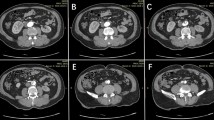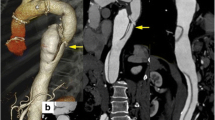Abstract
Although the surgical technique for acute type A aortic dissection dramatically improved in recent years, the postoperative mortality and morbidity rates remain high. After the emergency surgery for acute type A aortic dissection, a small tear in the aorta may result in dilation of the false lumen in the future. Some tears originate from the suture line on the anastomosis. This report introduces the novel “plaster technique” that involves using a single interrupted suture with felt and plastering a minimum dose of BioGlue into the suture hole. Similar to patients with acute aortic dissection, we found that the plaster technique using a felt pledget and minimum dose of BioGlue is effective for fragile aortic walls. Moreover, it is a simple, safe, and durable technique to strengthen the suture line.


Similar content being viewed by others
References
Geirsson A, Ahlsson A, Franco-Cereceda A, et al. Hospital volumes and later year of operation correlates with better outcomes in acute type A aortic dissection. Eur J Cardiothorac Surg. 2018;53:276–81.
Matalanis G, Ip S. A new paradigm in the management of acute type A aortic dissection: total aortic repair. J Thorac Cardiovasc Surg. 2019;157:3–11.
Suzuki S, Masuda M, Imoto K. The use of surgical glue in acute type A aortic dissection. Gen Thorac Cardiovasc Surg. 2014;62:207–13.
Mitrev Z, Belostotskii V, Hristov N. Suture line reinforcement using suction-assisted BioGlue application during surgery for acute aortic dissection. Interact Cardiovasc Thorac Surg. 2007;6:147–9.
Funding
None.
Author information
Authors and Affiliations
Corresponding author
Ethics declarations
Conflict of interest
The authors declare no competing interests.
Ethical approval
Institutional review board approval was exempt at our institution for this retrospective technique report.
Statement of human and animal rights
No human or animal subjects are involved for this retrospective technique report.
Informed consent
The requirement for patient consent was waived for this retrospective technique report.
Additional information
Publisher’s note
Springer Nature remains neutral with regard to jurisdictional claims in published maps and institutional affiliations.
Supplementary information
The turn up anastomosis for the proximal side during the ascending aortic dissection. The felt strip is placed outside the aorta, and the turn-upped prosthetic graft is inserted into the lumen. Four everting mattress stitches with 4–0 polypropylene are placed to fix the aortic wall and the prosthetic graft at 90° intervals; running sutures are performed by keeping the same depth of the suture to complete the anastomosis. (MP4 349,929 kb)
The plaster technique for the proximal anastomosis during ascending aortic dissection repair. After the anastomosis, the suture line is examined intraluminally for any new intimal tears caused by the suture, and to identify fragile parts of the intima. Intimal tears are repaired using a double-armed pledgeted 4–0 polypropylene suture. The suture is passed from inside the aortic lumen to the graft externally. In this case, the felt is reinforced with autologous pericardium. BioGlue is injected between the pledget and intimal layer. This technique can strengthen the suture line. Similar to the proximal side, plaster technique is performed in the distal-side anastomosis. This procedure is easy, even in a deep and narrow field. (MP4 311,202 kb)
Rights and permissions
About this article
Cite this article
Ishida, S., Mutsuga, M., Fujita, T. et al. Plaster technique for filling up a future entry at the suture hole in type A aortic dissection. Indian J Thorac Cardiovasc Surg 38, 339–341 (2022). https://doi.org/10.1007/s12055-022-01351-0
Received:
Revised:
Accepted:
Published:
Issue Date:
DOI: https://doi.org/10.1007/s12055-022-01351-0




